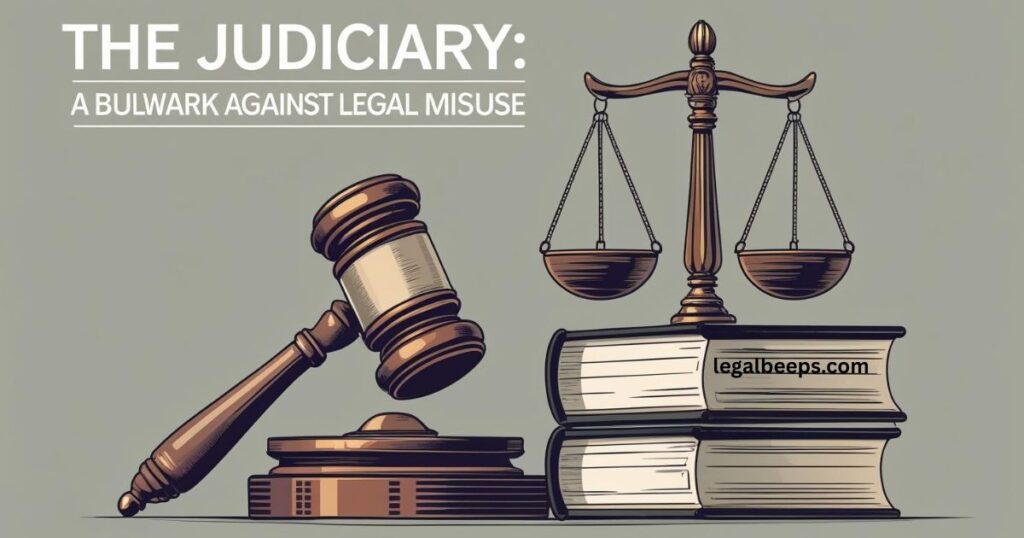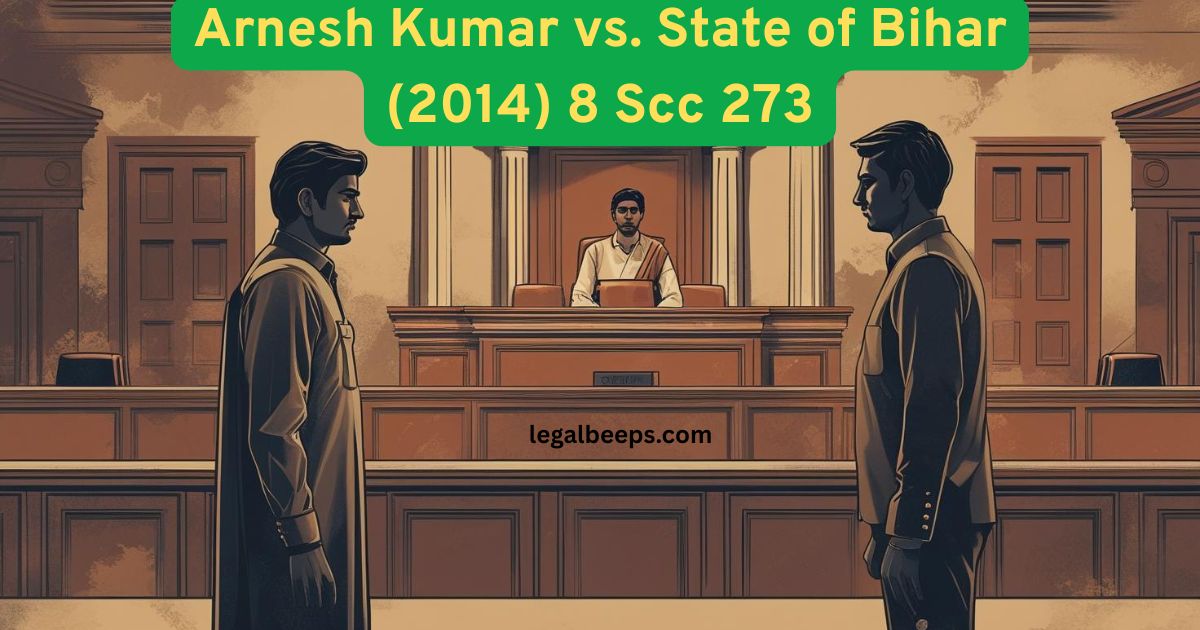The case of Arnesh Kumar vs. State of Bihar is significant in Indian law. It addresses the issue of misuse of the law in cases of arrest without proper evidence. The Arnesh Kumar vs. State of Bihar guidelines were issued by the Supreme Court to protect individuals from unnecessary arrests. The court’s decision emphasized the need for a more careful review before arresting individuals.
In the Arnesh Kumar vs. State of Bihar judgement, the court ruled that police must follow strict guidelines while making arrests in cases related to personal disputes. The Arnesh Kumar case brought clarity on how arrests should be handled, ensuring that arrests are not made in a hasty or unjust manner. It is a landmark case that has influenced the way arrest procedures are now carried out in India. The guidelines introduced by the court have helped safeguard citizens’ rights.
Facts of the Case
In the Arnesh Kumar vs. State of Bihar case, the complainant accused the appellant of dowry harassment and domestic violence. The FIR was filed under Section 498A, which deals with cruelty to women by their husbands or in-laws. The police arrested the accused without proper investigation or verifying the allegations. This case questioned the procedure for arresting individuals in such cases.
The case involved an important legal issue regarding the misuse of Section 498A. The appellant, Arnesh Kumar, argued that his arrest was unlawful and violated his constitutional rights. He claimed that there was no prima facie evidence to justify the arrest. The case raised concerns over the unnecessary arrests made in dowry harassment cases without sufficient evidence.
The Supreme Court was asked to examine the procedure followed by the police before making such arrests. In its judgment, the court recognized the need for a balanced approach in dealing with dowry harassment allegations. It stressed the importance of a preliminary investigation before making an arrest under Section 498A.
ISSUES
In the Arnesh Kumar vs. State of Bihar case, the main issue was whether the arrest made under Section 498A was justified without a preliminary investigation. The case questioned the legality of arresting an individual solely based on accusations of dowry harassment. It highlighted concerns over misuse of the law and whether arresting without evidence violated the accused’s rights. The case emphasized the need for a proper investigation before an arrest.
- Whether arrest without investigation violates rights
- Misuse of Section 498A in dowry harassment cases
- Need for clear guidelines for arrest in such cases
- Importance of a preliminary inquiry before arrest
- Ensuring fair treatment for the accused in dowry cases
LEGAL PROVISIONS ADDRESSED

- The Arnesh Kumar vs. State of Bihar case dealt with several key legal provisions. Section 498A of the Indian Penal Code, 1860, addresses cruelty by a husband or his relatives towards a woman. It mandates punishment with imprisonment and fine. The case brought attention to how this section was being misused in dowry harassment cases, leading to unnecessary arrests without proper investigation.
- The Dowry Prohibition Act, 1961, also played a role. Section 4 punishes those who demand dowry, either directly or indirectly, with imprisonment ranging from six months to two years and a fine. The law is designed to curb the practice of dowry and protect women from exploitation. However, the case highlighted concerns about false accusations and how this provision could be misapplied in certain situations.
- The case also addressed various sections of the Criminal Procedure Code, such as Sections 41 and 41A. Section 41 discusses when police can arrest without a warrant. Section 41A requires specific procedures for arresting without a warrant or order. The case emphasized the need for proper procedures to prevent unnecessary arrests and ensure the protection of individual rights during investigations.
- Article 22(2) of the Constitution of India was another key provision addressed. It ensures that any person arrested must be brought before a magistrate within 24 hours. The provision guarantees protection against unlawful detention and safeguards the rights of those accused of crimes, ensuring that any arrest follows due process. This legal protection prevents arbitrary or excessive detentions without proper legal procedures being followed.
JUDGEMENT
The judgement in Arnesh Kumar vs. State of Bihar focused on the issue of misuse of Section 498-A. The court observed that arrests under this provision should not be made automatically. It stressed the importance of ensuring that arrests are justified and not made in a hurried manner, especially for cases that involve dowry-related allegations.
The Court also highlighted the importance of following due process. Police should not arrest a person without a reasonable cause or proper investigation. The judgement helped clarify the legal process for dealing with complaints under Section 498-A and other similar provisions, ensuring a balanced approach.
This landmark ruling aimed to protect citizens from arbitrary arrests. The judgement also encouraged higher courts to supervise arrests and ensure justice is served, preventing misuse of the law.
GUIDELINES/DIRECTIONS
In the Arnesh Kumar vs. State of Bihar case, the Supreme Court issued specific guidelines to prevent the misuse of Section 498-A. The Court emphasized the importance of preliminary inquiry before arrest. It directed police officers to evaluate the gravity of allegations and avoid arresting individuals without strong evidence. The guidelines aimed to reduce unnecessary arrests and protect innocent people from harassment.
- Arrests under Section 498-A should only be made after proper investigation. The police must first assess the situation and gather sufficient evidence before deciding to arrest someone. This ensures that individuals are not wrongfully detained based on mere allegations without substantial proof of the crime.
- Police must conduct a preliminary inquiry to verify the seriousness of allegations. Before making any arrest, the authorities are directed to determine the severity of the accusation and whether there is adequate evidence to support the claims. This protects individuals from being wrongfully arrested without thorough investigation.
- Arrest should be avoided unless there is sufficient evidence of cruelty or dowry-related abuse. If the evidence is inconclusive or weak, arresting the accused could lead to unnecessary suffering and legal complications. The aim is to ensure that arrests are only made when the facts genuinely justify such an action.
- Arrests should not be automatic in cases of dowry-related allegations. In the past, arrests in dowry cases were often made hastily, without adequate investigation. The Supreme Court directed that arrests should not be the first response and should only be made when absolutely necessary and supported by substantial evidence.
- Bail should be granted if the accused is not a threat to public order. The Court indicated that bail should be considered a standard option unless there is clear evidence that the accused poses a danger to public safety or justice. This principle ensures fair treatment for individuals accused without sufficient proof.
- An FIR should not be filed casually; it must be based on clear evidence. The Supreme Court cautioned that filing a First Information Report (FIR) should not be done based on vague or unsupported allegations. Clear and credible evidence must be presented for an FIR to be filed, ensuring fairness in the legal process.
- Proper legal procedures should be followed, ensuring fair treatment for all parties involved. The Supreme Court emphasized that all parties, including the accused and the complainant, should be treated fairly and in accordance with established legal principles. The guidelines aim to ensure justice is upheld for everyone involved in dowry cases.
Criticisms and Reactions to the Judgement
The judgment in the Arnesh Kumar vs. State of Bihar case received mixed reactions. Many felt that the decision focused too much on protecting individuals from unnecessary arrest. Some critics argued that it would make it harder for victims of domestic violence to get justice. They believed the ruling might be misused to delay arrests in serious cases of abuse.
On the other hand, supporters of the judgment claimed that it was a necessary step. They argued that the excessive use of arrests for minor offenses had led to a clogged judicial system. They believed that the ruling would help in maintaining balance and reduce wrongful arrests. It was seen as a step towards protecting personal rights and curbing abuse of power by authorities.
The judgment led to further discussions about how the legal system should address domestic violence and dowry-related offenses. Critics argued that more specific laws and guidelines were needed to ensure that victims’ rights were fully protected, and justice was not delayed. The reactions highlighted the complexities of balancing individual rights with the need for swift justice.
Impact of the Arnesh Kumar Judgment on Police Procedures
The Arnesh Kumar vs. State of Bihar judgment brought major changes in how police handle arrests under certain laws. It made police officers more cautious before arresting someone without a warrant. They now need to follow clear guidelines and justify the need for arrest. This has encouraged more responsible policing and reduced cases of unnecessary custody in many parts of the country.
Police departments had to conduct training and awareness programs after the ruling. Officers were taught about the legal provisions and procedures they must follow before making arrests. This helped ensure better compliance with court directions. It also helped protect citizens from being arrested without proper reason or legal backing.
Despite concerns, the judgment is seen as a strong step toward legal accountability. It has encouraged police to act fairly and within the law. It also helped courts monitor how the arrest power is used. The decision reinforced the need to protect personal freedom while handling criminal complaints properly.
Role of Judiciary in Preventing Misuse of Laws

The judiciary plays a key role in stopping the misuse of laws. In the Arnesh Kumar case, the court made it clear that legal powers should not be misused. Judges reminded police and lower courts to follow the law strictly. This helps protect people from unfair arrests and supports justice in a fair and balanced way.
Courts now review arrest actions more closely than before. If police arrest without proper reasons, courts question them. This has created pressure on law enforcement to work within the legal limits. The judiciary ensures that people’s rights are not violated by rushed or careless decisions.
The ruling also reminded citizens about the power of the Constitution. It showed that the courts are there to protect every individual. The judgment proved that misuse of any law, even with good intention, can cause harm. The judiciary’s guidance helped bring clarity and justice in sensitive legal situations.
Also Read: The Golaknath Case and Its Impact on Constitutional Law in India
Impact of Arnesh Kumar Judgment on Law Enforcement
The Arnesh Kumar judgment brought clear changes to how police handle arrests. It reminded officers to follow legal steps before taking action. Arrests without proper reasons are now closely checked. This protects individuals from being held without strong evidence. The police must now give valid reasons before making an arrest under sensitive laws.
Training and awareness programs were started for law enforcement. These sessions help officers understand the judgment better. Police are taught to issue notices before arresting someone unless the situation is urgent. This avoids unnecessary arrests and supports fair investigation processes. Law enforcement now acts more carefully in such matters.
Many states updated their procedures after the judgment. Standard operating guidelines were created to follow the new arrest process. The court’s decision helped law enforcement balance between protecting victims and preventing false cases. Overall, the judgment led to more responsible policing and greater respect for individual rights.
Influence of Arnesh Kumar Case on Judicial Practices
The Arnesh Kumar case influenced how courts view arrests and bail. Judges now check if the police followed the right steps before approving custody. This ensures that the person’s rights are respected and no one is held unfairly. The judgment pushed courts to focus on fairness and proper reasons before allowing long detention.
The case encouraged courts to support the idea of notices before arrest. Judges now expect police to follow Section 41A of the CrPC carefully. This gives the accused a chance to appear without being arrested first. It promotes balance between justice and personal liberty.
Judicial training has also improved since this case. Judges are now more aware of arrest procedures and rights of the accused. Workshops and legal discussions often refer to this case. It has become a key example in maintaining justice while preventing misuse of power. Courts continue to follow its spirit in similar cases.
FAQ’s
What is the main issue in Arnesh Kumar vs. State of Bihar?
The case dealt with arrests in dowry complaints. It focused on preventing arrests without proper investigation or strong evidence.
What change came from Arnesh Kumar vs. State of Bihar?
The judgment created strict steps for police before arrest. It aimed to stop unnecessary jail and protect personal freedom.
Why did the court give directions in Arnesh Kumar vs. State of Bihar?
The court noticed misuse of Section 498-A. It tried to reduce false cases and protect innocent persons from harm.
What was the court’s goal in Arnesh Kumar vs. State of Bihar?
The court wanted to stop misuse of laws. It balanced justice and fairness for both the complainant and the accused.
Why is Arnesh Kumar vs. State of Bihar still discussed?
It set legal boundaries for arrests. It reminds law officers to act with caution and follow legal procedures correctly.
Conclusion
The case of Arnesh Kumar vs. State of Bihar changed how arrests are made in dowry-related matters. It helped stop misuse of laws and protected people from being arrested without strong reasons. The Arnesh Kumar judgement gave clear steps for police and courts to follow. These rules help maintain fairness and avoid unnecessary jail time for the accused.
Arnesh Kumar vs. State of Bihar also set a strong example for future cases. The Arnesh Kumar vs State of Bihar guidelines focused on personal freedom and legal checks. The Arnesh Kumar case reminded the system to respect rights while handling serious charges. This case, also known as Arnesh vs State of Bihar, gave a helpful structure. The Arnesh Kumar vs State of Bihar summary shows how courts can balance justice with fair process for all.

